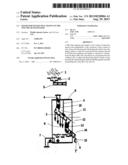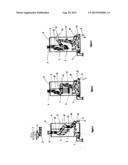Patent application title: SEPARATOR FILTER THAT ADAPTS TO THE VOLUME OF RAINWATER
Inventors:
Wadih Antonio Garios (Juiz De Fora, BR)
IPC8 Class: AC02F100FI
USPC Class:
21017003
Class name: Structural installation geographic for stormwater treatment (e.g., rainwater runoff, stormsewer treatment, etc.)
Publication date: 2013-08-29
Patent application number: 20130220904
Abstract:
A filter that separates and adapts to the volume of rainwater based on
the adaptability of the variations of the volume of rain, being
self-cleaning and eliminating the debris from the piping, made of a pipe
(3) connected by the entrance (4) and to the filter that separates and
adapts to rainwater's volume. Here the filters (10), (11) and (13) move,
programmed by the calibrator (5), to adapt and absorb the largest volume
of rain possible (6), eliminating the rubbish (15) through the exit (14)
and guiding the water (6) to the exit (7).Claims:
1. Separator filter that adapts to the volume of rainwater, comprising a
pipe (3) through which the collected rainwater from the catchment areas
passes, going to the entrance (4), from the separating filter and the
rainwater's volume adaptor (8) where the rainwater's separation and
classification begins. Made of the filters (10), (11) and (13), of
cylindrical form, the sides of the fabric and mobility for auto
adaptation to rainwater's volume; the calibrator (5), which is fastened
to the rod (9) is connected to the filter (11) to program its inclination
to different flows of rain. The filter (11) moves, creating variations in
angle (12) according to the water's flow, involving in this movement the
connected auto-retractable filters (10) and (13). The trash (15) is
disposed to out of the system through the exit (14). The water is
separated from the trash (15), and flows to the exit (7) following the
piping until the reservoir of water.Description:
[0001] The filter gathers rainwater from roofs and large rainwater
gathering areas, that thanks to its constructive, useful and specially
innovative characteristics, it stands out in an extremely practical and
efficient way.
[0002] The filter separates and deviates debris, with the aspect of stretching and moving itself, adapting to be able to collect the variations of the rainwater's volume, and also, eliminates from the system all the trash that comes from the surfaces above its fabric, eliminating the impurities gathered from the surfaces of catchment efficiently, while at the same time aiming for a good development of the next stages and equipments that may perhaps be used.
[0003] The first rainwater has a high concentration of rubbish that has accumulated with time, and is carried by the rain to the catchment system, causing problems to its equipment, components and possibly the health of any who may consume it.
[0004] There are, at present, various processes to collect and use rainwater. The simplest of them show water being collected directly into a cistern, yet in others the first rain waters are deviated manually until they seem clean to the naked eye to immediately be redirectioned to the utilization deposit.
[0005] In places where technology is available, several types of filters are used, some collect leaves, small animals and rubbish in its fabric, they may get soiled, obstructed and consequently do not absorb the waters completely, because they are not self-cleaning. Other filters, although they are self-cleaning, they waste water because they do not adapt to the volume of the rain. In this way they do not take advantage of the total flow of rainwater.
[0006] With the aim of solving the mentioned problems, and many other existing ones, and desiring to overcome them, a "rainwater catching, classifying and separating system" subject of this patent, was developed with characteristics that enable it to better absorb and taking more advantage of the rainwater. Being self-cleaning as well it avoids the concentration of the rubbish and eliminates the risk of this water's contamination.
[0007] This filter's special characteristic of adapting itself to take advantage of downpours, various degrees of intensity of rain, also moves, expands or contracts itself, and goes far beyond the traditional existing systems' catching of rain.
[0008] "The rainwater catchment, classifier and separator" subject of the present patent of invention, can be better understood through the following detailed description, in accordance to the attached picture.
[0009] FIGS. 1, 2 and 3 show a side view, with signs of water in the system and drawing in order to compose the patent of invention.
[0010] In describing the invention in detail, as is seen in the FIGS. 1, 2,3 and 4 that accompany this descriptive report: "Rainwater gathering, classifying and separating system" is made of individual parts (3) where the pipe is through which the received rainwater passes from the catchment surfaces or the roof collectors, etc. initiating the separation and classification of the waters by the entry (4), connecting to the separating filter and deviator of debris (8); the waters, until then, have carried all the rubbish deposited through time, at the collecting surface. The water flow, with its rubbish, passes through the filtering device that has a tubular form composed of the filters (10, 11 e 13). The filters (10), (11) and (13) use the water (6) in its entire surface if necessary. Besides tubular, its walls are made of cloth and move to adapt to the volume of the rain (6) eliminating the trash (15) easily. The filters (10) and (13) are made of cloth, articulate, auto-expansible and self-expansive according to the water flow. They are previously calculated with filter (11) to adapt to a determined water flow according to the calibrator (5).
[0011] If receiving a downpour or sudden rain, at that moment the filter (11) that is stuck to the rod (9) adapts itself to this water flow and changes its inclination, so expanding its filters (10) and (13), which increasing their absorption area to intake the most possible rainwater. See also FIGS. 1, 2 and 3 respectively related to the increase of the rain flow.
[0012] The filters (10), (11) and (13), have their initial position calculated for the easy ejection of trash from the system. They have an increased inclination when there's softer rain, which allows the exit of debris (FIG. 1) changing this position proportionately with the rain's increase, tending toward the position in FIG. 2, and gradually arriving at the position of FIG. 3; depending on the rain flow. At a given moment, after reducing this water flow, the filter (11) begins to return to its initial programmed position, and the filters (10) and (13) begin to, retract proportionately, increasing the filter's (11) inclined angle (12) to facilitate the elimination of the trash (15) with a smaller amount of water (FIG. 1).
[0013] Even when inclined against the water flow during strong rain, FIG. 3, all the debris will be expelled from the system. The filter (11), as was said, may be in a declining, flat or even in an active position,
[0014] Because of the climatic changes and thanks to the mobility of the filtrating elements (10), (11) and (13), with permeable walls, we will take more advantage of the rain, even of its sudden variations, compared to the existing filters for this purpose that waste a precious amount of water (6). Furthermore, they keep their capacity to absorb water, for they do not keep the trash, rather they expel it from the system.
[0015] With systems that don't possess the characteristics of constitution and mobility there will be more water waste. Thus we see a great advantage in the technique of this separating and debris diverting filter (8). The calibrator (5) programs the inclination of the filter (11) that is connected to the filter (10) and (13) adjustable to any determined spill of the rainwater flow in the piping. The filter (11) is fastened onto a rod (9) but it can be fastened in other position as well. The trash (15) made of leaves, small branches, insects, geckos, bats, etc. . . is disposed of through the exit (14) of the system, since a leaf, or similar (15), could hinder the full exploitation of this water and also hinder any equipment that may be connected to the filter, like for example, sensors, turbidimeters, valves, water pumps, etc. . .
[0016] Filters (10, 11, 13) are fundamental to the system, because it avoids rubbish (15) from passing straight through the piping and entering in the water reservoir. The water (6) is separated from the trash (15) and flows through the exit (7), the trash (15) is carried through the exit (14) with a right amount of water (6).
[0017] Because the garbage is eliminated at the beginning, damages to the system and to the person using it are avoided.
User Contributions:
Comment about this patent or add new information about this topic:


